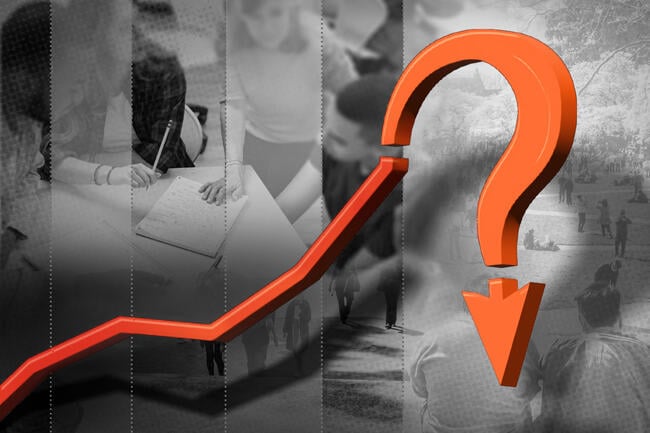You have /5 articles left.
Sign up for a free account or log in.

While enrollment numbers continue to climb, the forecast demographic enrollment cliff may impede post-pandemic recovery.
Photo illustration by Justin Morrison/Inside Higher Ed | gmc3101/iStock/Getty Images | andresr/E+/Getty Images
Undergraduate enrollment remains slightly below 2020 levels, but college enrollment as a whole is making a steady recovery, driven in part by growth in certificate programs and at two-year public institutions, according to new data from the National Student Clearinghouse Research Center.
The clearinghouse’s latest report, published Wednesday, shows 18.4 million students were enrolled in higher education this spring, a 3.2 percent year-over-year increase.
Undergraduate enrollment jumped 3.5 percent from spring 2024 but remains down 2.4 percent from 2020. Similarly, graduate enrollment grew 1.5 percent—to 3.1 million students—compared to spring 2024, and 7.2 percent from 2020.
For years, researchers have forecast that a decline in the number of college-aged students will negatively impact college enrollment levels, but the data has yet to show that drop.
“We are not yet seeing here declines that have been projected for the number of high school graduates in the coming years,” said Doug Shapiro, executive director of the NSCRC, during a press briefing on Wednesday.
Nontraditional programs continue to see gains, including certificate programs and vocationally focused programs at two-year institutions, while enrollment at four-year institutions hovers below pre-pandemic levels.
“As we’ve been saying for some time now, students are voting with their feet in favor of shorter-term credentials at low costs and with more direct job-related skills,” Shapiro said.
Young adults are also enrolling in higher education at greater rates; the data shows a 3.2 percent uptick among 21- to 24-year-olds compared to last spring, and a 5.9 percent increase among 25- to 29-year-olds. This spring is the first time since 2020 that 20-somethings have seen year-over-year growth, Shapiro noted.
Despite the dramatic changes to higher education this spring, Shapiro said there’s no indication in the data that enrollment will drop. But year-to-year retention rates have remained high in recent years, which could bode positively for total numbers at institutions.
“If that’s any indication that we will have more continuing students in the fall, that might even offset any changes in potential declines in the number of freshmen,” Shapiro said.
Business and Health
Undergraduate certificate programs boosted overall enrollment numbers, particularly for community colleges. The number of students enrolled in certificate programs this term jumped 4.8 percent from last spring, and 20 percent compared to spring 2020. Over 610,000 students (of 4.6 million total) at community colleges are enrolled in a certificate program.
More on the Report
The National Student Clearinghouse Research Center publishes the Current Term Enrollment Estimates series every January and May, reporting fall and spring enrollment, respectively. The report includes national enrollment estimates submitted by institutions and arranged by credential type, institutional sector, enrollment intensity, age group, gender, major field and state-level estimates.
Trade-focused institutions also saw substantial increases in enrollment (11.7 percent), making up 19.4 percent of two-year enrollments at public institutions.
Similarly, rural institutions and historically Black colleges and universities reported jumps in enrollment this spring, of 11.7 percent and 5 percent, respectively.
Public four-year colleges saw a 2.5 percent increase in enrollment, bringing the total number of students to 7.4 million—slightly higher than the pre-pandemic level. Private four-year nonprofit institutions saw a 5.3 percent increase and for-profit institutions a 1.4 percent gain.
Business and health professions continue to drive undergraduate enrollment growth at four-year institutions, with enrollment in those programs of study growing 4.8 percent and 6.3 percent, respectively. The number of students enrolled in public administration and social service professional programs grew for the first time in five years, at 7.8 percent year over year.
More students opted in to health professions programs at two-year and primarily associate degree–granting baccalaureate institutions, as well as mechanic and repair technologies and construction trades, again showing a shift toward career-oriented programs.
“These growths are highly emblematic of the turn toward vocational programs and skilled trades in community colleges,” Shapiro said.
Enrollment Gains Vary by State
All regions in the U.S. saw gains in enrollment, but some states within those regions saw lower numbers of students compared to the previous spring.
Idaho had the greatest decline, with a 6.2 percent decrease (just over 7,600 students), followed by Alaska, which saw a 3 percent drop (601 students) and Vermont, where enrollment declined 2 percent (nearly 700 students).
Among the states that gained students this spring, Utah saw the most dramatic growth, with a 9.4 percent increase in enrollment (21,604 students). Oklahoma enrolled 7.3 percent more students (12,283 students) and Mississippi reported a 6.6 percent enrollment gain (9,341 students).
Primarily online institutions or those operating in multiple states reported a sharp rise in enrollment as well, growing 3.9 percent compared to spring 2024 and 22.3 percent compared to 2020.
Some states have recovered to pre-pandemic levels of enrollment, with the greatest increases in Utah (17.8 percent from 2020 to 2025), Georgia (9 percent), Arizona (7.5 percent), Kentucky (7.2 percent) and South Carolina (7.2 percent).




